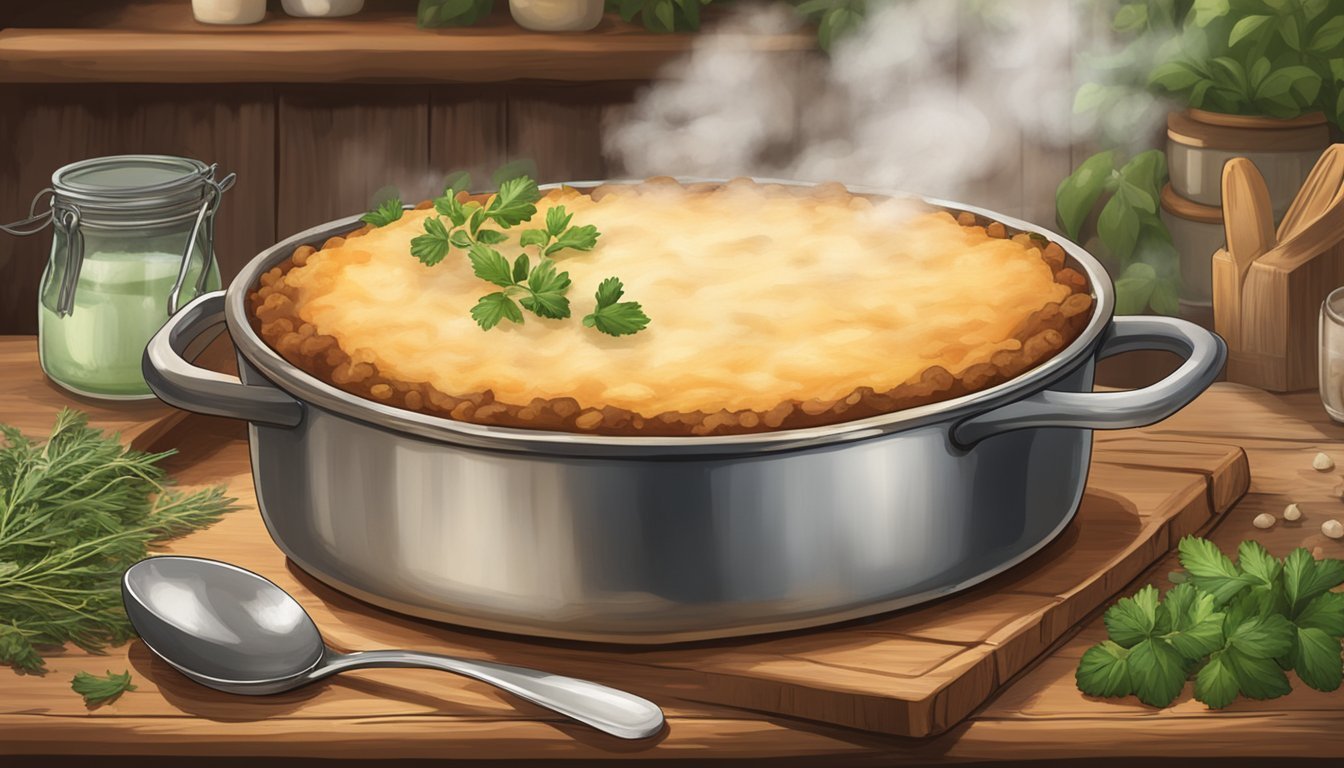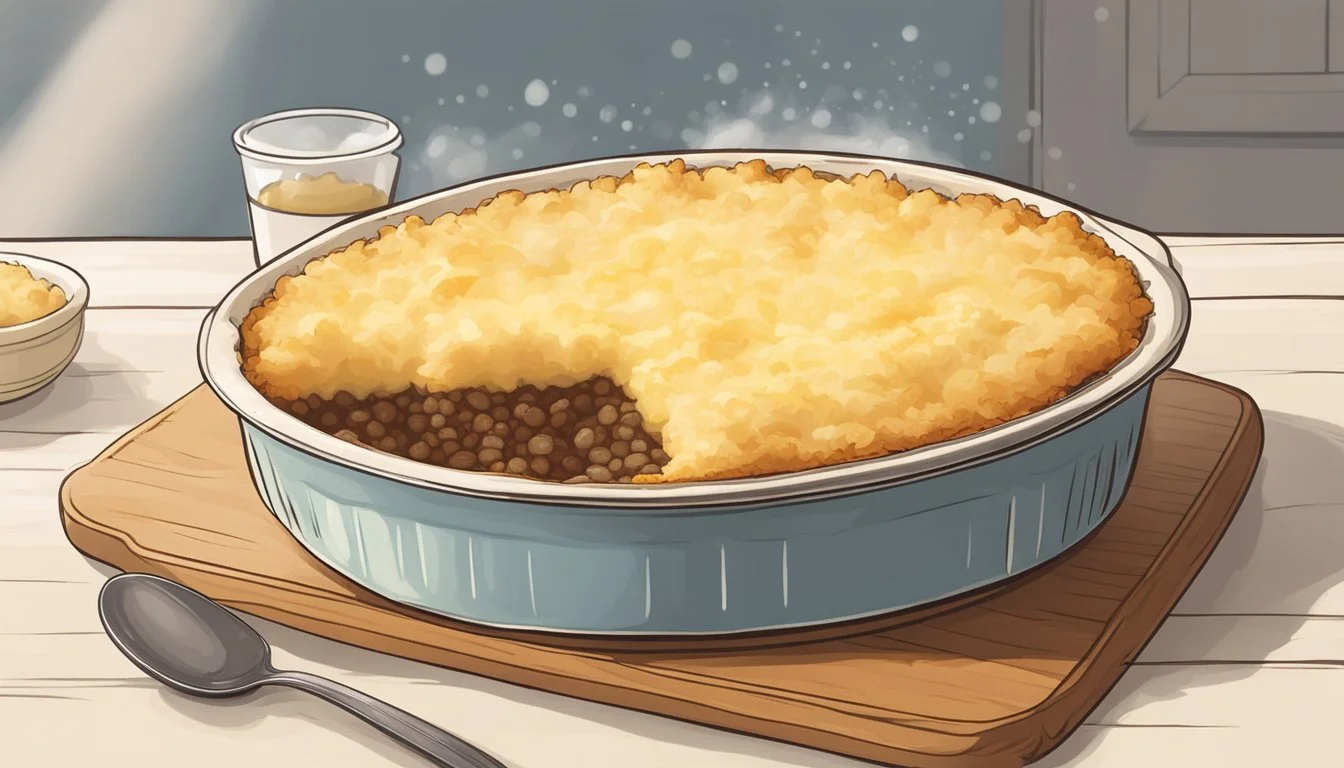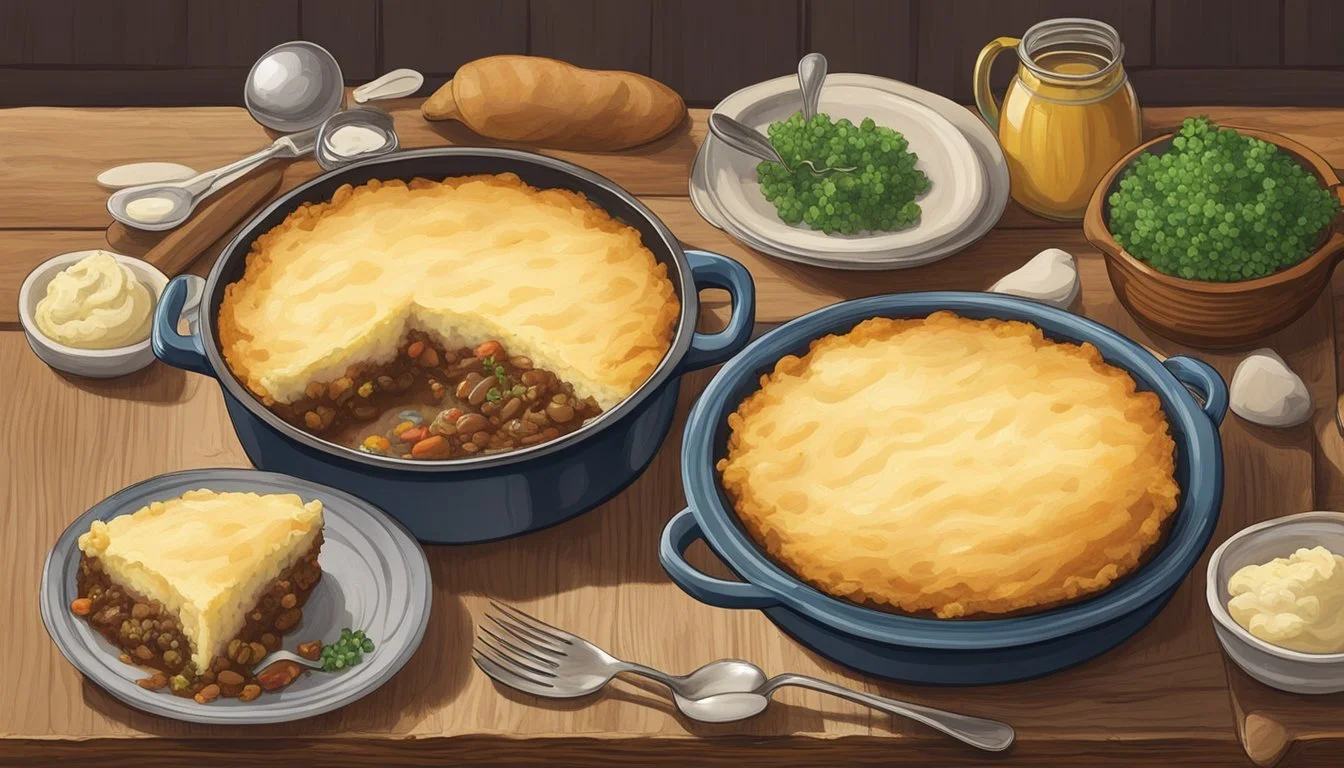Best Way to Reheat Cottage Pie
Techniques for Fluffy and Creamy Leftovers
Reheating cottage pie can seem like a challenge, especially when attempting to maintain the dish’s signature fluffiness and creaminess. The key to achieving this lies in understanding the different methods and the subtle intricacies of each approach. A well-reheated cottage pie should bring back the comforting warmth and rich flavors that make this dish a beloved comfort food.
The microwave and oven are the most commonly used methods for reheating cottage pie, each with its own set of guidelines to ensure the pie returns to a palatable temperature without sacrificing its texture and taste. The microwave offers a quick solution, requiring a careful balance of power settings and timing. To achieve the best results without the sogginess that often accompanies microwave reheating, it is important to let the pie sit at room temperature briefly before microwaving and to heat in intervals, stirring gently partway through.
On the other hand, the oven method, while more time-consuming, tends to provide a more even reheat and can restore the crispness to the pie's topping. Heating in an oven preheated to an appropriate temperature and using coverings like foil can prevent the top layer from drying out or burning. This method allows the entire dish to warm through slowly while preserving its creamy texture and layers of flavor.
Understanding Cottage Pie
Cottage pie is a traditional British dish that has been savored for generations. It is a hearty, comforting meal typically made with minced beef as the base. This savory delight is often confused with shepherd's pie, but the main difference lies in the meat used; shepherd's pie is made with mince lamb instead.
The pie usually includes a layer of vegetables like carrots, peas, onions, and sometimes celery. These components are gently sautéed together to create a rich base full of flavor.
The meat and vegetables are cooked in a thick, flavorful gravy often enhanced with Worcestershire sauce to add depth and a slight tang. This mixture forms the bottom layer of the dish.
A hallmark of cottage pie is its topping of creamy, fluffy mashed potatoes. The mash is spread across the meat layer and often raked with a fork to create peaks that brown beautifully when baked.
Below is a breakdown of cottage pie's traditional layers:
Layer Ingredients Bottom layer Minced beef, onions, other vegetables, gravy, Worcestershire sauce Top layer Mashed potato
When reheated properly, the cottage pie retains its original textures and flavors, with the mashed potato topping remaining fluffy and the filling staying moist and creamy. It's important for the dish to be heated through to a safe temperature without compromising its signature mouthfeel.
Food Safety Considerations
When reheating cottage pie, one must prioritize food safety to prevent bacterial growth and ensure the meal remains safe for consumption. Adhering to safe storage and reheating practices can minimize foodborne illness risks.
Preventing Bacterial Growth
Bacteria can proliferate on food between temperatures of 40°F and 140°F, a range known as the "danger zone." To mitigate this risk:
Reheat leftover cottage pie to an internal temperature of at least 165°F to eliminate most harmful bacteria.
Do not reheat the pie more than once, as fluctuations in temperature can increase bacterial growth.
Proper Storage Before Reheating
Proper storage is key to maintaining both the safety and quality of leftover cottage pie:
Refrigeration: Cool the cottage pie to room temperature and promptly store it in the refrigerator. Cottage pie should be refrigerated within two hours of cooking to reduce the risk of bacteria.
Freezer: For longer storage, wrap the cottage pie in plastic wrap, aluminum foil, or place it in a freezer bag before storing in the freezer.
Oven-safe dishes: When ready to reheat, transfer the pie to an oven-safe dish if it was stored in plastic or any non-oven-safe container.
Cover: Lightly cover the pie with aluminum foil during reheating to maintain moisture without trapping excessive heat that could promote bacteria growth.
Preparation for Reheating
To achieve the best outcome when reheating cottage pie, one must take steps to ensure even heat distribution and the preservation of the pie's textures. Thawing, preheating, and careful preparation of the pie surface are essential for restoring the dish's fluffiness and creaminess.
Thawing Frozen Cottage Pie
If the cottage pie is frozen, it should be moved to the refrigerator to thaw slowly; this gradual thaw maintains the quality of the mashed potatoes and crust. A complete thaw can take up to 24 hours, so planning ahead is vital.
Preheat the Oven
Before one begins to reheat the cottage pie, they should preheat their oven. Set the temperature to 350°F (175°C), and allow the oven to come to temperature. This ensures an even and gentle reheating process, which can help maintain the integrity of the dish’s crust and creamy mashed potato topping.
Preparing the Pie Surface
Before placing the cottage pie in the oven, the reheating process benefits from a few preparatory steps that involve the pie's surface:
Mashed Potatoes: One may opt to add a thin layer of butter or cheese on top to add moisture and flavor.
Crust: Covering the dish with aluminum foil can prevent the crust from becoming too hard or burning. This retains the crust's original texture and ensures an even reheating of the fillings underneath.
By following these steps, one is positioned to reheat cottage pie in a way that aims to preserve its quintessential qualities.
Reheating Techniques
Reheating cottage pie properly is crucial for maintaining its texture and flavors. The choice of method can make a significant difference in the outcome.
Oven Method
To reheat cottage pie in the oven, one should first preheat the oven to 350°F (175°C). The pie must be placed in an oven-safe dish if it's not already in one. For even heat distribution, it's recommended to slice the pie into individual portions. These slices should then be arranged on a cookie sheet lined with parchment paper or placed back into the pie dish.
Covering the Pie: To prevent the top from burning or drying out, lightly cover the portions with aluminum foil.
Reheat Time: Place the dish on the center rack and reheat for 25-30 minutes. Since ovens may vary, one should check the pie after 25 minutes and adjust time accordingly.
Microwave Method
If time is of the essence, one can use the microwave to reheat cottage pie quickly.
Settling Time: It is a good practice to let the pie sit at room temperature for about 10 minutes before microwaving.
Microwave Settings: Use the defrost or reheat setting and start with a 2-3 minute interval.
To avoid "hot spots" and uneven heating, one should stir the pie (if possible) halfway through the reheating process and add extra time in one-minute increments if needed.
Alternative Methods
While not as common as the oven or microwave methods, an air fryer can be an alternative for reheating cottage pie, though one should be meticulous with time and temperature to avoid overcooking.
Preparation: Place the pie in an air fryer-safe dish or foil.
Reheat Time: Cook at a lower temperature — around 300°F — for about 10 to 15 minutes, checking frequently to ensure it doesn’t dry out.
Each reheating technique can be effective if followed correctly, taking into account appliance variations and specific dish requirements to maintain the cottage pie's desirable creaminess and fluffiness.
Maintaining Texture and Flavor
To ensure that a reheated cottage pie retains its original delight, one must focus on avoiding sogginess, ensuring even heating, and preserving the outer crispiness that provides contrast to the soft interior.
Avoiding Sogginess
To prevent the filling from becoming soggy, it is important to reheat at a temperature that warms the pie without causing steam to compromise the texture. Using aluminum foil can protect the surface of the pie from becoming too wet by absorbing excess moisture.
Recommended approach: Reheat the cottage pie covered with foil, thus trapping steam and preventing it from settling back onto the pie.
Ensuring Even Heating
An unevenly heated cottage pie will have hot and cold spots, affecting both safety and enjoyment. The internal temperature should reach at least 165°F (74°C) to guarantee it is piping hot throughout.
Oven Method:
Heat at 350°F (175°C).
Place the pie in the middle of the oven for even circulation of heat.
Check with a thermometer at the center for proper internal temperature.
Preserving the Crispiness
The crust and top layer of mash in a cottage pie should ideally maintain a crisp quality. This contrast in textures is part of what makes the dish satisfying.
Technique:
Remove the foil for the last few minutes of reheating.
Optionally, a brief broil can add crispness to the crust without overcooking the middle.
Serving the Reheated Cottage Pie
Once the cottage pie reaches a piping hot temperature, it's time to focus on presentation. Serving a reheated cottage pie tastefully can make the experience just as delightful as enjoying it freshly made.
Garnishing and Serving Recommendations
For the garnish:
A sprinkle of freshly chopped parsley or chives adds a touch of color and freshness.
A light drizzle of olive oil or a pat of butter on top can add a rich sheen.
When serving:
Use a sharp knife to cleanly slice the portion sizes.
Ensure each portion is served piping hot, uniformly heated to allow the flavors to shine.
Be mindful of not disturbing the fluffy top layer; a careful slide of a pie server under each portion can help preserve its texture.
Pairing with Sides
A well-paired side dish complements the hearty flavors of the pie:
Steamed green beans or peas are classic accompaniments, light and refreshing against the rich filling.
A simple green salad with a vinaigrette dressing offers a crisp contrast.
For added heartiness, consider roasted root vegetables, such as carrots or parsnips.
By following these tips, the reheated cottage pie will look inviting and taste as good as when it was first baked, whether it's served with a simple salad or a full array of sides.
Tips for Leftovers and Storage
Proper storage of cottage pie leftovers is crucial for maintaining its flavor and texture. This section will provide guidance on storing remaining portions and the correct method for freezing and defrosting to enjoy the pie at its best.
Storing Remaining Portions
To store leftover cottage pie, one should allow it to cool to room temperature before the storage process to prevent condensation within the container, which can lead to sogginess. Once cooled, portioning the pie into serving sizes can save time and simplifies reheating later. Each portion should be placed in an airtight container or wrapped in aluminum foil.
Storage Steps:
Cool the cottage pie: Let it sit until it reaches room temperature.
Divide into portions: This facilitates ease of reheating later.
Transfer to the storage container:
Small Portions: Use an airtight container.
Large Portions: Loosely cover with foil or wrap in clingfilm.
Refrigerate: Place the container in the fridge if consuming within a few days.
Freezing and Defrosting
Freezing cottage pie is a practical option for extending its shelf-life. Wrap the pie or individual portions securely in plastic wrap and then in foil to prevent freezer burn and odor absorption. Place it in a freezer bag, label it with the date, and store it in the freezer.
For defrosting, transitioning the pie from the freezer to the refrigerator allows for a slow and safe thaw overnight. It's essential not to defrost at room temperature as this could lead to bacterial growth. Once thawed, the pie can be reheated as per the guidelines for optimal flavor and texture retention.
Freezing Steps:
Wrap: Securely wrap the portion in plastic and then in foil.
Bag: Place it in a freezer bag to protect against freezer burn.
Label: Mark the bag with the current date.
Defrosting Steps:
Refrigerate: Move the frozen pie to the fridge.
Time: Allow it to defrost overnight.
Check: Ensure it's thoroughly defrosted before reheating.
Frequently Asked Questions
Q: What is the best way to reheat a cottage pie to maintain its texture?
A: Using an oven often yields the best results for reheating cottage pie. For a 9-inch pie, one should preheat the oven to 350°F (175°C) and heat for 15-20 minutes, whereas a 5-inch pie requires 12-15 minutes, and turnovers about 10-12 minutes. Cover the pie with foil to prevent drying; for a crispy top, remove the foil towards the end of heating.
Q: Can I reheat cottage pie in the microwave?
A: Yes, if pressed for time, reheating in the microwave is feasible. It is advised to let the pie sit at room temperature for 10 minutes before heating on a defrost or reheat setting for 2-3 minutes, checking frequently to ensure even warming.
Q: How do I ensure my cottage pie is safely reheated?
A: For food safety, the reheated cottage pie must reach an internal temperature of 165°F (74°C). To check, insert a food thermometer into the center of the pie. Additionally, ensure that the minced beef within the pie is fully heated through.
Q: Can I reheat a cottage pie that was frozen?
A: Yes, for a frozen pie, one should thaw it overnight in the refrigerator before reheating. Follow the oven method for reheating, adjusting the time as needed to account for the lower starting temperature.
Q: Is it necessary to fully bake a cottage pie before reheating leftovers?
A: Yes, one should always fully bake cottage pie before storing it as leftovers. This ensures that the pie is properly reheated, retaining its flavor and texture when warmed again.






